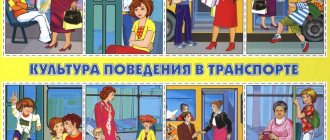Are there any rules of behavior for children on public transport? The question is far from idle. Firstly, any transport is a zone of increased danger for any person, and even more so for a child. And secondly, many children absolutely do not know how to behave in transport. They run, jump, make noise, climb onto seats in their shoes, it happens that they paint the interiors of buses and trolleybuses with all sorts of designs, break and even cut chairs with knives... A familiar picture, isn’t it? And the most important and terrible thing is that young passengers often endanger their lives and even the lives of other passengers.
Alas, there are no rules specifically written for children on how they should behave on public transport. There are approved rules for all passengers in general, regardless of age. But, of course, children are not interested in them. And therefore, parents need to further explain to their young brats how they should behave on trams, trolleybuses, buses and other types of public transport. Let's talk about this in more detail.
Pictures of road signs
Clear drawings of signs with analogies will help you remember the most important symbols that you will encounter on your way to elementary school or kindergarten. Vivid images and simple explanations allow you to instantly attract attention and convey information quickly, cheerfully and clearly.
Thanks to road pictures, the child learns to be independent and make the right decisions. The main goal is to show that participation in traffic is not as scary as it may seem. If you understand the meaning of road signs, you can organize your own actions.
Road pictures are different for each age category. Children learn in the presence of an adult, who prompts actions and explains signs.
Punch card “Pedestrian crossing”
Goal: To consolidate children’s knowledge about the rules for crossing the road at a pedestrian crossing, about the pedestrian traffic light and its signals.
Children's task: Color the circles opposite the picture. Use a red pencil if the children's actions in the picture are not correct, green - if the children's actions in the picture are correct. Explain why children’s actions are correct in some situations and incorrect in others.
Pictures of traffic rules for children
This is a fun activity for different age groups, which at the same time brings great benefits. Every child, just starting to walk, becomes a participant in traffic - goes to kindergarten or school, walks in the yard, learns to ride a bicycle. Studying from strict books is boring and difficult, so as an alternative we offer bright drawings with clear messages.
The learning process attracts the child with its accessibility and diversity. Any adult can help understand the images by adding examples from personal experience to the drawing. As a result, confidence in himself and his actions in any situation is formed, he will not be confused or scared at the sight of a moving car and will know what to do at a pedestrian crossing. Traffic rules drawings are quick answers to children's questions.
How to behave while driving in a vehicle
There are also rules on this matter.
- You must not make noise, play loud music, push, run around the cabin or cause other inconvenience to passengers.
- Transporting combustible, flammable and sharp objects on public transport is prohibited. It is also prohibited to transport objects and substances that could stain other passengers.
- It is prohibited to distract the driver while the vehicle is moving.
- You cannot lean out of windows when traffic is moving.
- While moving, you should hold on to the handrails or straps to avoid falling.
- If possible, while driving it is better to stand facing the direction of travel of the bus or trolleybus.
- If you need to transport an animal on a bus, you should remember that they are transported according to certain rules. Cats and birds are kept in special cages, and dogs must be muzzled and on a leash.
When entering a bus, tram or trolleybus, you must remove your backpack or bag and place it in a place where it does not interfere with other passengers.- While on a bus, you should not shake snow or raindrops off your clothes, as they will certainly fall on other passengers and cause them inconvenience.
- While in the cabin, you should give up your seat to the elderly, disabled, women with small children or with a heavy load.
- You must pay for the fare or have a document ready that allows you to travel for free, so that you can present it to the controller at any time.
- If the bus is crowded, you should try your best not to cause inconvenience to other passengers, and apologize if any inconvenience was caused.
- If there is nothing to hold on to in a crowded vehicle, and a child is holding an object, you should ask the seated passengers to hold it. There is no need to be shy here, this is in the order of things, and will in no way violate the rules of travel.
- But looking at passengers point-blank, making faces at them, looking at their phones or books, leaning on them is indecent, and, moreover, often leads to misunderstandings and conflicts. Therefore, it is better not to do any of the above.
- Of course, you cannot be rude to other passengers - even in response to rudeness on their part.
- You must not dirty or damage the seats or other parts of the interior of a bus, tram or trolleybus.
- Of course, you can’t touch other people’s things (even touch them), otherwise, what’s good, the child may be mistaken for a thief.
- In addition, on the bus it is not customary to comb your hair, clean your nails, eat cakes or ice cream, discuss your problems loudly on the phone or in a conversation with other passengers, or laugh loudly.
- You need to prepare for the exit in advance (especially if there are a lot of people in the cabin). At the same time, you should not fight your way to the doors, pushing aside other passengers. This should be done delicately and politely, asking the passenger in front if he is getting out, and if he is not getting out, then offer to change places with him.
How to behave on trains
There are also specific rules of behavior here.
- You should behave decently in the carriage, without disturbing order or causing inconvenience to other passengers and conductors. However, children do not travel on trains independently, but only accompanied by adults, so responsibility for the behavior of children lies with mothers, fathers or other accompanying persons. And if a child forgets and begins to behave incorrectly in the carriage, the parents must immediately pull him back and explain exactly how to behave.
- If adults are not around for some reason, the child must remember the following rules of behavior:
- do not come close to the cars until the train stops;
- do not lean against the carriages - even if the train is not moving;
- do not open the doors and windows of the carriage while moving and even when the train is stopped;
- do not lean out of doors and windows;
- do not interfere with the closing of the carriage doors;
- do not touch the stop valve;
- do not disturb passengers when boarding or disembarking.
How to behave on water transport
In this case, in addition to the generally accepted rules listed above, there are some specific rules. It is forbidden:
- board or disembark the ship until it has completely moored to the pier and the gangway has been opened;
- come close to the side of the vessel - especially without adult accompaniment;
- enter the ship's areas where there are no fences;
- enter technical and office premises;
- hang over the side.
As for behavior on an airplane, everything is relatively simple. Children never fly unaccompanied by adults - this is prohibited by special transportation rules. Therefore, during the trip, the child must follow all the instructions and comments of the adult and, accordingly, forget about any independence. An airplane is not a vehicle where children are allowed any kind of freedom.
Road alphabet in pictures
This is play-style learning. Vivid images are better remembered and attract children's attention better than dry texts and abstruse phrases. This alphabet has a dual function - visual teaching of literacy plus familiarization with road traffic and its participants. The child will easily remember the order of letters in the alphabet and their spelling, and will also know the designations of markings, signs, vehicles, etc.
The participation of an adult in the process of learning the alphabet can only be limited to testing the acquired knowledge. Colorful pictures and simple explanations are learned by children of different ages. As a result, the child is well oriented in traffic situations, learns in which places to cross the road, and will be able to distinguish between traffic lights and road sign designations.
How to get on and off public transport
There are special rules in this regard that children need to know.
- You must wait for a bus, trolleybus or other means of transporting passengers in special places - at stops. Trying to stop it in some other places is wrong. This can create an emergency situation and, as a result, put the life of the child and other people at risk.
- You should only get on a bus or tram when it has completely stopped. Jumping into open doors while walking is prohibited.
- If the vehicle is full, it is better to wait for the next one.
- Before entering a bus, tram, etc., you must wait until other passengers get off.
- You should board the bus slowly, without jostling or trying to get ahead of other passengers.
- Once on the bus, you should not stop at the door (unless you need to get off at the next stop). It is necessary to go deeper into the cabin to make room for exiting passengers.
- There is no need to push and break through to the exit of the vehicle first. You need to go out decorously and calmly, observing the order.
- After getting off the bus (tram, trolleybus), you need to wait until it leaves and only then cross the street.
- You should always remember and follow the golden rule, which states that the tram should be walked around in front, and the trolleybus and bus - behind.
Non-existent road signs
This is a great conceptual way to develop a child's understanding of the world. Based on simple drawings, the child develops logical thinking, associative perception, and adapts to social life. Road traffic is an integral part of modernity, vehicles and pedestrians intersect everywhere. Understanding the basics of traffic rules means being safe.
Pictures with non-existent road signs are beneficial because they develop in the child an idea of real symbols that need to be followed. At the same time, fantasy develops thanks to imaginary objects. Children easily reproduce or invent new colorful images. This learning process is built in a game format and is preparatory to further study of the signs from the Rules.








